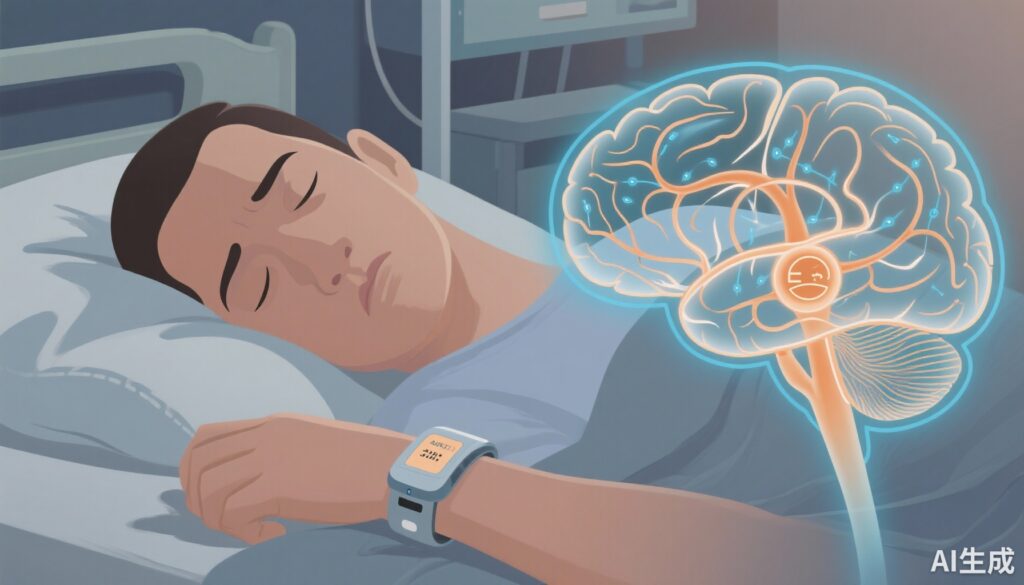Highlight
1) Executive dysfunction is a recurrent, clinically important feature in Wolfram syndrome and may reflect WFS1-related cellular stress that perturbs neurotransmitter systems involved in planning, inhibition, and emotional regulation.
2) Molecular links between endoplasmic reticulum (ER) stress, mitochondrial signaling and circadian clocks provide biological plausibility for circadian dysregulation contributing to the neurobehavioral phenotype.
3) Chrono‑informed assessment (diurnal symptom mapping, actigraphy, chronotype questionnaires, sleep studies) and pragmatic chronotherapy (light, melatonin timing, sleep–wake scheduling) represent testable, low‑risk clinical strategies that merit evaluation in Wolfram syndrome.
Background and Disease Burden
Wolfram syndrome (WS) is a rare, autosomal recessive neurodegenerative disorder typically characterized by juvenile-onset diabetes mellitus, optic atrophy, diabetes insipidus, and sensorineural hearing loss. Mutations in WFS1 (most common) and, less frequently, CISD2 underpin the multisystem phenotype. Beyond classical somatic features, patients frequently experience progressive neurologic and psychiatric problems that reduce quality of life, accelerate functional decline, and complicate care coordination across specialties.
Neurobehavioral issues in WS are heterogeneous but often include mood disturbance, anxiety, and cognitive problems—particularly deficits of executive function (planning, cognitive flexibility, inhibition, working memory). Sleep-wake disturbances and daytime fatigue are also commonly reported and may amplify neuropsychiatric symptoms, yet systematic chrono-informed evaluation is uncommon in routine care.
Study Design (Scope of the Evidence Considered)
This article critically interprets findings from a recent scoping review and empirical observations reported by Esteban-Bueno et al., who combined literature synthesis with results from the Dysexecutive Questionnaire (DEX) applied to a Spanish WS cohort (Diagnostics 2025). The original work frames mechanisms connecting WFS1-related ER stress to monoaminergic and cholinergic dysfunction, and highlights putative links with circadian regulation via ER–mitochondrial interactions and clock-controlled gene expression. Here we synthesize those arguments, situate them within clinical practice, and propose pragmatic assessment and intervention pathways while identifying priority research questions and methodological considerations.
Key Findings and Interpretation
1. Executive dysfunction is a salient feature in Wolfram syndrome
Across case series and the scoping review, executive deficits recur as a prominent cognitive complaint in WS. In the Spanish cohort described by Esteban-Bueno et al., elevated DEX scores suggested difficulties with planning, inhibitory control, and emotional regulation. Although sample sizes are limited by disease rarity and heterogeneity, convergent observations from clinical reports and caregiver accounts support that dysexecutive symptoms can be both disabling and under-recognized.
2. Mechanistic hypothesis: WFS1 mutations → ER stress → neurotransmitter dysregulation → executive dysfunction
WFS1 encodes wolframin, an ER membrane protein implicated in calcium homeostasis and ER stress responses. Chronic ER stress can trigger maladaptive unfolded protein response signaling and intersect with mitochondrial function. Esteban-Bueno et al. propose that such cellular stress perturbs serotonergic and cholinergic neurotransmission—systems integrally involved in attention, cognitive control, mood regulation, and sleep architecture. This pathway provides plausible biological grounding for observed deficits in planning, inhibition, and affective stability.
3. Circadian biology as a mediating/modifying factor
ER and mitochondrial signaling are both under circadian modulation, and conversely, prolonged cellular stress alters clock gene expression in model systems. Clinically, sleep disturbances (insomnia, fragmented sleep, altered sleep timing) and daytime fatigue are frequently reported in WS, raising the possibility that circadian dysregulation either contributes to or exacerbates executive and psychiatric features. Esteban-Bueno et al. frame this link as hypothesis-generating: the available human data are associative and mechanistic causality remains unproven.
4. Implications for diagnosis: Toward chrono‑diagnosis
Integrating circadian metrics into neuropsychiatric assessment (sleep diaries, actigraphy, chronotype scales, timed symptom logs) may reveal diurnal patterns that clarify symptom drivers and suggest personalized interventions. For example, worse inhibitory control later in the day could indicate phase delay or sleep debt as contributors rather than primary neurodegeneration alone.
5. Potential chronotherapeutic strategies
Given low risk and translational rationale, chrono‑informed interventions—timed bright light exposure, melatonin or melatonin agonists appropriately scheduled, structured sleep–wake timing, and chronotherapeutic scheduling of psychotropic or stimulant medications—are reasonable to consider within multidisciplinary care, ideally under study protocols. Cognitive rehabilitation and behavioral sleep interventions remain important adjuncts.
Expert Commentary and Mechanistic Insights
The proposal linking WFS1-related ER stress to both neurotransmitter disturbances and circadian disruption is biologically plausible and congruent with broader literature showing bidirectional interactions among ER stress pathways, mitochondrial dynamics, and molecular clocks. Key strengths of the argument include its integrative nature and potential to connect somatic cellular pathology with observable behavioral phenotypes.
However, several caveats are important. First, most human WS studies are small, observational, and subject to ascertainment and reporting biases. Second, direct measures of central serotonergic or cholinergic function in WS are sparse. Third, the temporal relationship—whether circadian disruption is a cause, consequence, or bidirectional amplifier of neuropsychiatric features—remains to be delineated. Finally, therapeutic extrapolation from general circadian medicine to WS requires empirical validation; response to melatonin or light therapy in WS could differ from other populations because of underlying neurodegenerative processes.
Clinical Recommendations—Practical, Low-Risk Steps
Assessment
– Routinely screen for executive dysfunction and mood/anxiety symptoms using brief clinician-rated and caregiver-rated tools (e.g., DEX, brief executive test batteries, PHQ-9/GAD-7 adapted for cognitive impairment).
– Add chrono-informed tools: 1–2 week sleep diary, wrist actigraphy (objective sleep–wake patterns), and a validated chronotype questionnaire (e.g., Morningness–Eveningness or Munich Chronotype Questionnaire).
– For patients with troubling sleep complaints or suspected circadian disorder, consider referral for polysomnography (if obstructive or parasomniac contributors suspected) or circadian specialist input.
Management
– Implement sleep hygiene and structured sleep–wake scheduling as first-line measures.
– In suspected delayed or advanced circadian phase problems, consider timed bright light therapy or melatonin under clinician guidance; timing is critical and should follow circadian principles to avoid phase-shifting in the wrong direction.
– When prescribing psychotropic medications for mood or attentional symptoms, consider time-of-day dosing to align with circadian patterns and to minimize sleep interference; consult psychiatry for medication choices sensitive to cholinergic/serotonergic profiles.
– Cognitive rehabilitation targeting planning and inhibitory control, and caregiver education, can mitigate functional impact.
Research Agenda and Priority Studies
To move from hypothesis to evidence, the following research priorities are proposed:
1) Prospective cohort studies combining neuropsychological batteries, objective circadian and sleep measures (actigraphy, melatonin profiles), and biomarker panels (ER stress markers in peripheral blood, where feasible).
2) Mechanistic work using patient-derived cellular models (iPSCs) to examine how WFS1 mutations modulate clock gene expression, neurotransmitter biosynthesis pathways, and ER–mitochondrial cross-talk.
3) Small pilot randomized trials of chronotherapy (timed light, melatonin) with cognitive and mood endpoints to estimate effect sizes and feasibility in WS.
4) Development of consensus recommendations for chrono‑assessment in rare neurogenetic disorders to harmonize data across centers and facilitate pooled analyses.
Limitations
The current evidence base is limited by small samples, cross-sectional designs, and reliance on subjective symptom reporting. Molecular links are plausibly extrapolated from preclinical work but lack robust in vivo human confirmation. The proposals here should therefore be viewed as clinically pragmatic and research-oriented rather than definitive standards of care.
Conclusions
Executive dysfunction and psychiatric symptoms are clinically salient in Wolfram syndrome and deserve systematic attention. The emerging hypothesis that WFS1-related ER stress interacts with circadian mechanisms to produce or amplify neurobehavioral symptoms is biologically plausible and clinically actionable. Integrating chrono‑diagnostic tools into routine assessment and testing low-risk chronotherapies in structured studies offers a promising translational pathway that may improve daytime function and quality of life for people with WS. Multidisciplinary collaboration, harmonized data collection, and focused pilot trials will be essential next steps.
Funding and ClinicalTrials.gov
No specific funding or trial registrations are reported in this interpretive essay. Clinicians and researchers interested in interventional studies should consider registering prospective trials (ClinicalTrials.gov) and seeking multi‑center collaboration to overcome recruitment challenges inherent to rare disorders.
References
1. Esteban-Bueno G, Jiménez-Soto A, Fernández-Martínez JL, Fernández-Vilas E, Coca JR. Circadian Rhythm and Psychiatric Features in Wolfram Syndrome: Toward Chrono Diagnosis and Chronotherapy. Diagnostics (Basel). 2025 Sep 15;15(18):2338. doi: 10.3390/diagnostics15182338. PMID: 41008710; PMCID: PMC12468670.
2. Wolfram syndrome. OMIM. https://omim.org/entry/606201. Accessed 2025.
3. Wolfram syndrome. Orphanet Encyclopedia. https://www.orpha.net/consor/cgi-bin/Disease_Search.php?lng=EN&data_id=810. Accessed 2025.
Thumbnail image prompt (AI‑friendly)
A composed medical illustration: a side view of a human head with an outlined frontal lobe highlighted in warm color; overlay of a stylized endoplasmic reticulum and mitochondria inside a neuron; a wrist wearing an actigraphy band in the foreground; a background split between soft blue (night) and warm amber (day) to suggest circadian rhythm; clean, professional, slightly abstract, high-resolution.



